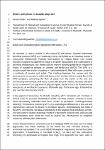What’s really down the hospital plughole?
| dc.contributor.author | Butler, J | |
| dc.contributor.author | Upton, Mathew | |
| dc.date.accessioned | 2023-05-05T11:32:53Z | |
| dc.date.available | 2023-05-05T11:32:53Z | |
| dc.date.issued | 2023-08 | |
| dc.identifier.issn | 0195-6701 | |
| dc.identifier.issn | 1532-2939 | |
| dc.identifier.uri | https://pearl.plymouth.ac.uk/handle/10026.1/20824 | |
| dc.description.abstract |
As reported in recent articles in this journal and others, hospital wastewater plumbing systems (WPS) are increasingly being highlighted as an important source of nosocomial infections [ [1] , [2] ]. Potential interventions to mitigate these risks include changes in patient management through to engineering solutions and modifications to plumbing infrastructure, with recent calls to improve building guidance to mitigate the impact of suboptimal designs on patients and healthcare staff [ [3] ]. The WPS is a complex interlinked system of pipework that is intermittently filled with water containing a multitude of solutes and solids. The interface between this system and the environments we occupy is within sink traps, which connect sinks to waste flow in the WPS periphery, preventing the flow of gases from the sewer to the sink and surrounding environment. Sink traps in particular become heavily colonized with (and act as a reservoir for) opportunistically pathogenic bacteria such as Pseudomonas aeruginosa, Acinetobacter baumannii, Klebsiella spp., Citro-bacter spp., Enterobacter spp. and Serratia marcescens [ [2] ]. | |
| dc.format.extent | 92-93 | |
| dc.format.medium | Print-Electronic | |
| dc.language | en | |
| dc.publisher | Elsevier BV | |
| dc.subject | Humans | |
| dc.subject | Hospitals | |
| dc.subject | Wastewater | |
| dc.title | What’s really down the hospital plughole? | |
| dc.type | journal-article | |
| dc.type | Letter | |
| plymouth.author-url | https://www.webofscience.com/api/gateway?GWVersion=2&SrcApp=PARTNER_APP&SrcAuth=LinksAMR&KeyUT=WOS:001060238000001&DestLinkType=FullRecord&DestApp=ALL_WOS&UsrCustomerID=11bb513d99f797142bcfeffcc58ea008 | |
| plymouth.volume | 138 | |
| plymouth.publication-status | Published | |
| plymouth.journal | Journal of Hospital Infection | |
| dc.identifier.doi | 10.1016/j.jhin.2023.04.005 | |
| plymouth.organisational-group | |Plymouth | |
| plymouth.organisational-group | |Plymouth|Research Groups | |
| plymouth.organisational-group | |Plymouth|Faculty of Health | |
| plymouth.organisational-group | |Plymouth|Research Groups|Institute of Translational and Stratified Medicine (ITSMED) | |
| plymouth.organisational-group | |Plymouth|Research Groups|Institute of Translational and Stratified Medicine (ITSMED)|CBR | |
| plymouth.organisational-group | |Plymouth|REF 2021 Researchers by UoA | |
| plymouth.organisational-group | |Plymouth|Users by role | |
| plymouth.organisational-group | |Plymouth|Users by role|Academics | |
| plymouth.organisational-group | |Plymouth|REF 2021 Researchers by UoA|UoA01 Clinical Medicine | |
| plymouth.organisational-group | |Plymouth|Faculty of Health|School of Biomedical Sciences | |
| plymouth.organisational-group | |Plymouth|Users by role|Researchers in ResearchFish submission | |
| plymouth.organisational-group | |Plymouth|Research Groups|Plymouth Institute of Health and Care Research (PIHR) | |
| dc.publisher.place | England | |
| dcterms.dateAccepted | 2023-04-13 | |
| dc.date.updated | 2023-05-05T11:32:52Z | |
| dc.rights.embargodate | 2024-4-17 | |
| dc.identifier.eissn | 1532-2939 | |
| dc.rights.embargoperiod | forever | |
| rioxxterms.versionofrecord | 10.1016/j.jhin.2023.04.005 |


